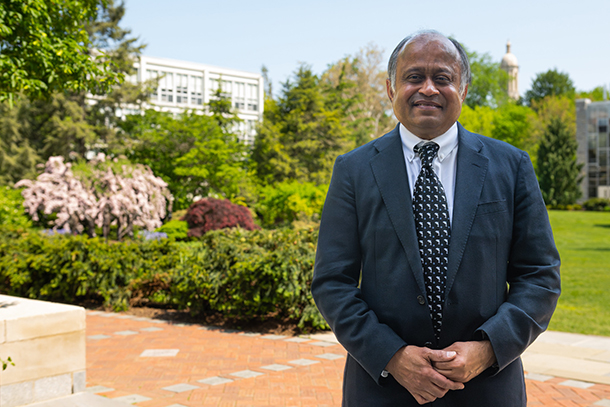
Madhavan Swaminathan, CHIMES director, head of electrical engineering and William E. Leonhard Endowed Chair in the Penn State School of Electrical Engineering and Computer Science. Credit: Tyler Henderson/Penn State
CHIMES reflects on success, looks to lead semiconductor research in year two
November 1, 2023
By Sarah Small
UNIVERSITY PARK, Pa. — The Penn State-led Center for Heterogeneous Integration of Micro Electronic Systems (CHIMES) held its first annual center review on Sept. 5-6 at University Park. The meeting was attended by representatives from the fifteen university partners as well as by the Semiconductor Research Corporation (SRC), industry sponsors and the Defense Advanced Research Projects Agency. CHIMES, which is one of seven centers funded through the SRC’s Joint University Microelectronics Program 2.0, is led by Madhavan Swaminathan, head of electrical engineering and William E. Leonhard Endowed Chair in the Penn State School of Electrical Engineering and Computer Science.
Below is a Q&A with Swaminathan about the annual meeting, the progress CHIMES has made and its goals for the upcoming year and beyond.
Q: What were some of the major accomplishments in the center’s first year?
In the first year of CHIMES, we demonstrated good team building across the center by directors, principal investigators and students. As a center we were able to set our goals, gain clarity and develop depth on proposed approaches and successfully manage challenges. We did a great job onboarding many new students and having them participate in the annual review on short notice. Through a flipped panel on broadening participation, we were able to hear fresh ideas directly from students and engage with them for insightful discussions. On the technical front, we showed significant progress in advancing the State of the Art (SOTA) with specific focus on power delivery, integrated voltage regulators, silicon with GaN Integration, materials for thermal management and multi-functional thermal management and electro-thermal modeling. The feedback that we received from our sponsors is that CHIMES is a role model for other centers.
Q: Would you discuss the importance of the partnerships and the role that Penn State is playing as the leader of CHIMES?
The technical focus of CHIMES is complex and cuts across many areas. We need top notch faculty working in these areas, and this is where our partners come in—our 14 university partners are key to the success of CHIMES and to the principal investigators involved. Ultimately, a center can only gel together if there is a cohesive vision and technical approach that brings the various elements together. That is the role of Penn State as the leader of CHIMES. I strongly believe that Penn State with its partners will define the future of semiconductor packaging through CHIMES.
Q: What are your goals for the next year for the center?
With funding from the CHIPS Act on the horizon, I believe CHIMES can play a critical role in helping the U.S. establish leadership in semiconductor packaging. This requires a vision that combines technical leadership with workforce development. In parallel, we will continue to advance SOTA based on a 10-year roadmap that we have developed working closely with our university partners and sponsors. We currently have 83 graduate students supported in the center, but education goes far beyond just graduate students. A major focus for CHIMES in year two would be to get undergraduate students involved through several Research Experiences for Undergraduates programs.



